 Interview with Kazilla
Interview with Kazilla
 Interview with Chris Valdes
Interview with Chris Valdes
You say your work is about the fundamentals of
aesthetics and humanity. Could you elaborate please?
The idea is basically: Where do we come from? What are
we doing? Where are we going? That is the very simplified version. I go at it
through what I believe is something we all universally share, which is, quite
often, food. For almost all of my career at this point it has all been food
related, in one form or another. The new installation at the Bass Museum of Art
is probably the farthest even though it still has a food reference. It refers
to the eco system and some place that food comes from but not as directly as me
giving somebody a piece of food in the past. Aesthetically it is very hard
edged minimalist. The artist is removed but there is always my hand in there in
some kind of twist in one form or another.
How do you deal with the decomposition aspect of food
materials?
I make a lot of sculptures that are functional. That
is the more permanent part. I have done things that leave a mark or a stain. It
is a spin-of or sometimes it is a byproduct. I have done all these barbeque
sculptures and I ended up doing these barbeque drawings. My studio used to have
an alley and I used to barbeque out there and it started making a stain on the
wall. This nice fade of smoke on the wall. So I thought what if I put a piece
of paper there? I refined that after a few trials and errors and I ended up
with something I call “smoke drawing.” It is a record of the barbeque, of the
process. It is always either media driven or process driven to some degree.
Could you tell us about your public art project for
the Bass Museum?
It is an installation that consists of eight paintings
and 700 hand-tied fishing flies, which mimic and also represent the little bait
fish that live in Biscayne Bay. The paintings are of the grass flats of
Biscayne Bay that have damaged areas where boats have carelessly driven across.
When they drive across it the propellers just destroy everything. It literally
has to be put back together by hand. It needs the certain microorganisms in the
sand to grow and if they are not there then the grass just won’t grow back.
Aren’t there regulations against that?
There are tons. If you get caught it costs thousands
of dollars. They fine you by how many
feet you made. There are markers. Some people don’t know which is scary. You
don’t need to have any kind of licensing to drive a boat. You do not need to
have a driver’s license in Florida. It is a free for all. So this new
installation is the most ecological that I have done. All the pieces are super
multi-faceted even though they are very clean, precise and conceptual. They
always encompass as many things and have as many facets as possible.
Would you say aesthetics is not your primary concern?
It is. I cannot get away from it. I went to art school
and I appreciate well crafted beautiful things so I strive to create well
crafted pieces. I make a lot of works that fail in the studio, technically,
made out of weird organic materials. I do not know it until I try it.
What are some of the materials you tried and that did
not work?
Spirulina was definitely one of them. The algae they
put in protein shakes and vitamins. It is really interesting. It almost has a
double helix. Spirals. It is a super food and it has all these great
nutritional aspects to it and it grows really easy. People can farm it. I did
these works on paper and I was mixing it with alcohol and got a beautiful stain
on the paper. Just pour in on a paper and let it do its own little thing. The
color, the pigment of the algae would move so there would be a faint stain and
when I turned the paper over the color would be on the other side. It was moving
back and forth through the paper. The first little hint of sunlight and it
disappeared. It is not a very dramatic failure but a frustrating one.
Did you have dramatic failures with other organic
materials before?
Yes, using chocolate powder. Everything wanted to eat
it. It attracted roaches. Pure wine pigment is another one I found. It is a
natural dye and also a vitamin supplement. You know it is considered THE
antioxidant. The roaches loved it. I was doing drawings and leave and come back
and they were eating away on the paper. My studio used to be un-air-conditioned
and basically borderline open to the outside. I am always concerned about longevity.
What are some of the forthcoming projects you are
planning or working on now?
I want to re-explore fish prints that I have done. It
is sort of a continuation of the Biscayne Bay stuff. It was even a thought to
incorporate a fish from Biscayne Bay into some of the fish prints that I have
done. I had a solo show last year that showed a bunch of them and I had some
commissions right before that. They are very simple, one fish, one piece of
paper. I want to push it and get more abstract and do multiple prints and see
where I can take it beyond just “this is a fish.”
Are you also working towards another exhibition?
Not at the moment, no. I wanted to be in this show but
got shut out because I was the wrong nationality. The piece was really interesting
and I will make the piece regardless. It’s a piece about bacalao, which is
salt-dried cod fish, which basically allowed the colonization of the world. The
project was about the ties between the Caribbean and Spain. Great piece. The
piece consists of nine vessels filled with salt and each containing a cured
fish with the little tail sticking out. It is a drawing at this point. The
vessels will be made out of tropical hardwood and the salt will be from the
Atlantic Ocean which is the body that joins these two areas of the world.
Are you actually from Miami?
Yes. I am third generation on one side of my family
and second on the other.
What do you love about Miami?
The water. Everything that’s here. For me it has
always worked out. It fits my lifestyle. New York has never been that appealing
as a place to permanently be. I love to visit it. I can have an amazing quality
of life here and work a normal job. We bought a house and have a boat. It is
great. It fits me.
What do you think about the progress of the art scene
here in Miami?
It is a mixed blessing. There are both, positive and
negative aspects about it. I guess it generally is more good than bad. I have
been hanging out in Wynwood since Locust Projects first opened up and I met
Dorsch when he bought the building for his gallery. That was the two things
that were here. That, and a bunch of sketchy people. We had a studio in the
Design District for seven years I shared with five other guys. We saw the
Design District change a lot. Now you have high design but no cutting-edge
contemporary art. It has faded away compared to what it used to be.
What is the market like in Miami? Are there enough
collectors and buyers to sustain it?
There is. We have several of the top 100 collections
in the world here. Amazing. I work for Museovault so I see and handle a lot of
the collections in town, for the institutions and private. There are definitely
people who support the Miami artists a lot. There is Rosa De La Cruz, a
tremendous supporter and almost a mentor in some ways. When I was finishing up
art school and starting my career she bought several pieces of mine and sent me
off to see art in different places and shared a lot of knowledge. Beyond my
college classroom and studio practice I had no idea what the art world was
really about. I got to see a little bit of it.
What originally started your interest in food?
I always cooked and ate. As a kid I would watch
cartoons and cooking shows. The serious focus on it, taking it to another
level, happened in college. I got into art school, into New World, as a
ceramics major. I knew nothing of art history, nothing of contemporary art. I
got in there and got exposed to all this stuff and thought, what am I going to
do? Also at the same time I started to get really interested in food and it
kind of morphed together. Different cooking methods have always been an
interest.
What are some of the ingredients that you have never
experimented with from an art perspective but you definitely still want to try?
The odder things. I have never explored insects or the
indigenous pre-Colombian South American stuff. It has been 14 years of
exploring food. I have done potatoes. I have done grain. I have done all kind
of different wine stuff. I have done different spices like the peppercorn piece
that is currently at the Museum of Art in Fort Lauderdale. I have done stuff
with saffron. Salt is one, like in the bacalao piece, I still want to do. I
have never really produced a series of works with salt. I tried to make
salt-crystal curtains but it did not work.
When last did you do ceramics?
It has probably been four years. The pieces that I
made were small sculptures. They are these cutesy bulbous formations based on
yeast. There are different strains that make more carbon dioxide and other ones
that make more ethanol. It is really interesting. It is the perfect model for hedonism.
These little creatures eat up all the foods first that is available to them,
which is glucose and then their byproduct is carbon dioxide and ethanol.
Ethanol is poisonous to any and all living things. In enough concentration it
will kill a plant, it will kill us. And, it kills the yeast. So the yeasts goes and goes and the byproduct
is that they create a toxic environment.
Is all your work based on scientific research?
These are things I find in research and it is always
well founded. I don’t make up a lot.
Is it relevant to you whether people who engage with
you work understand the processes and details of your work?
It is a bonus. I try to balance out the aesthetics and
the conceptual aspect so you get something no matter what.
Do you often have conversations about your work and
about your audience’s experience with your work?
Yes. It is not easy. There is a door or a small window
but there isn’t a neon “open” sign per se. There is not a “keep out” sign.
Please tell us more about the peppercorn piece you mentioned
This piece is simply about black peppercorns and
minimalist art. However, the history of black peppercorns is anything but
simple as is the conceptual foundation of minimalist art. Peppercorns are one
of most used spices in the world today. They have been a desired commodity for
a thousand years or so. Notable examples include the spice trade from India and
China as well as the later westward exploration by Christopher Columbus and
other explorers looking for wealth and the later pillaging of the British East
Indian Trading Company. I am drawing lines between current desired commodities
like fossil fuels and our thirst for them and our forefather’s thirst for
spice. I have found myself asking, why haven’t we learned from them and are
just repeating history again and again? And then we can start to explore the
twist on formal aesthetic concerns I expand upon with the smell, texture and
physical interaction of a work of art. This piece draws from floor works of
Carl Andre and earth works of Robert Smitherson adding my own conceptual
concerns. The first time I showed “Untitled (Black Pepper Corns)” it was at a
gallery called Invisible Exports. It is a small alternative gallery in New
York. There was literally a foot and a
half on each side that you could walk around so it was a long narrow space. And
people still didn’t want to walk on it. At the end of the night people were
playing with it. People were having fun with it. It is replenishable. It is
along the lines of Felix Gonzales Torres’ work in some way. The concept is what
it is. My hand is not that important in the fabrication. It is a circle. You
just put it in a circle and that’s it. It is not a special artist circle. A
circle is a circle.
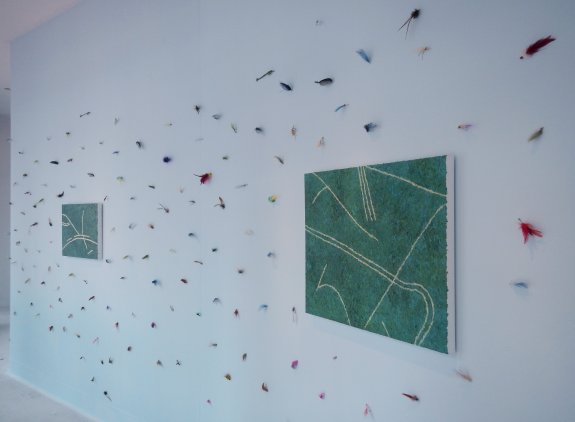
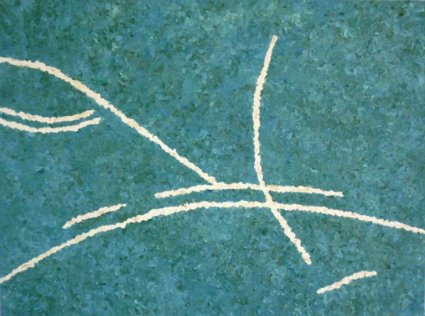
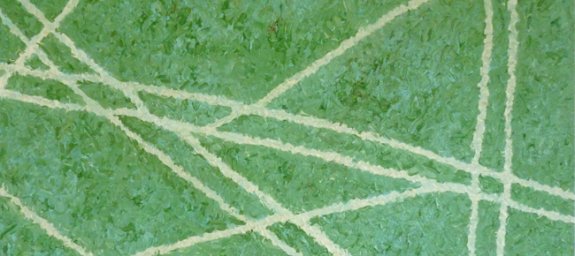
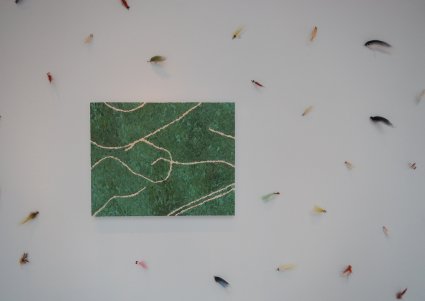
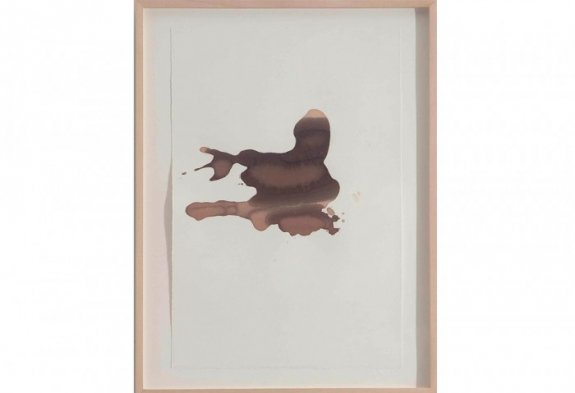
 Heike Dempster
Heike Dempster